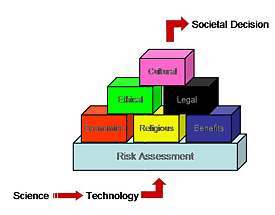Exposure Assessment
Exposure assessment is the determination or estimation of the route, amount, frequency, and duration of exposure.
Risk Characterization
This is the final step in the process. It is the description of the nature and probability or magnitude of the risk. The risk often will be described with the inherent assumptions and uncertainties.
Risk Management
Risk assessment is the science-based process which provides the technical characterization of risk. But societal decisions about risk generally require more than the results from the scientific assessment. Thatís where risk management fits in. Risk management is the process of considering social, cultural, economic, and political concerns in the process of problem formulation and also monitoring the risk assessment throughout its various stages. Additionally, risk managers formulate the risk assessment conclusions along with social, cultural, economic, and political concerns in making and implementing policy.
Risk Communication
Risk communication is an interactive process of risk information and opinion among individuals, groups, and institutions. This definition is important because it places more emphasis on interactive exchange or dialogues among stakeholders and less emphasis on traditional one-way delivery of risk messages from experts to the public.

|
Class Exercise - Demonstration of the Steps for Conducting a Risk Assessment
Letís use the table salt example we discussed in the last section (Risk as Science). Assume that the salt shaker filled with 3 tablespoons of salt is confined to the classroom and the only students in the classroom are the ones in your class. Also assume that before class you have sprinkled a total of 1 tablespoon (about 18 grams) across the floor and desks.
- Problem Formulation: What is the stressor? What is the extent or scope of the problem? Does the stressor (salt) have the potential to affect other people or organisms outside of the classroom? How might people in the classroom become exposed to the salt?
- Hazard Identification: Is salt the only hazard? What about the shaker? How does salt have the ability to do harm to people?
- Dose-Response Relationships: How much salt is necessary to harm a student? Assume the LD50 (the dose necessary to kill 50% of the test animal population) for salt is 3 g/kg body weight for humans. A lethal dose for a 154 pound person would be 210 grams (about 11 tablespoons).
- Exposure Assessment: How might a student become exposed to the salt? What routes of exposure are possible (inhalation, dermal, oral)? When and where in the classroom could the student be exposed? Would the exposure be acute (one or two days) or chronic (several days to weeks)? How could you measure exposure?
- Risk Characterization: To characterize the risk, you will need to compare the estimated exposure to a toxicological endpoint. So, divide the estimate of the amount of exposure (g/kg body weight) by the LD50 (3 g/kg body weight). How close is the estimated exposure to the LD50? What are some other ways you can express the risk?
|
Now that we have a better understanding of risk, risk assessment, and risk analysis, we can discuss the risks for biotechnology crops, how those risks are assessed, and how regulatory decisions are made.
|











